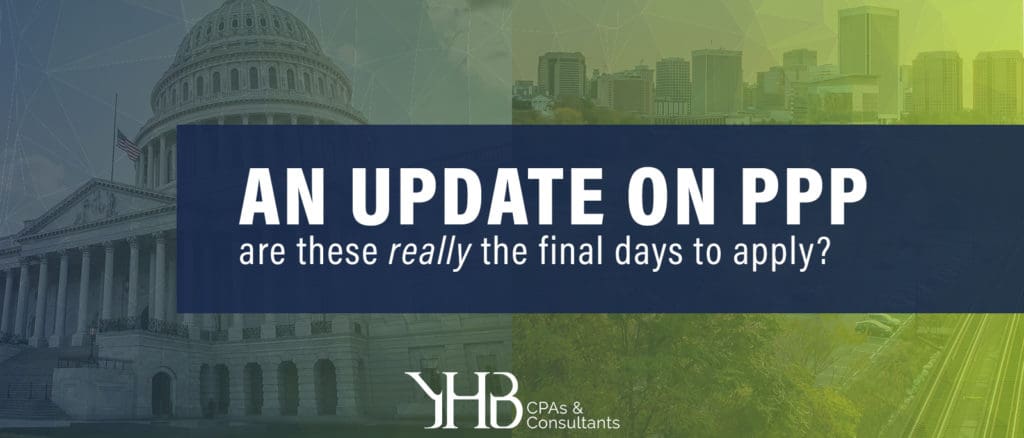
The Coronavirus Aid, Relief and Economic Security Act (CARES Act), which launched in April 2020, established the Paycheck Protection Program (PPP) to help employers cover payroll during the ongoing COVID-19 pandemic. Since the programs release employers and advisors (including YHB) have been tirelessly keeping up with the constant release of new guidance, including the introduction of the Paycheck Protection Program Flexibility Act of 2020 in May. (Learn more about the PPP Flexibility Act of 2020 here)
As we head into the (possible) final days before the August 8th deadline to apply for the PPP, it’s important to remember a few key points and recent changes to the original law:
- Payroll Allowable Costs can be adjusted to 60% with 40% other accounts allowable
- Forgiveness period to use PPP funds was increased to 24 weeks (it was originally 8 weeks)
- Funds received from PPP would create income once the forgiveness has been determined from your banking partner, creating possible Income Tax implications
- You have 5 years to pay back your PPP loan if the amount provided does not convert into a grant
But more importantly, if you haven’t applied for PPP and need it, you should! There is over $100 Billion still available for qualified recipients.
Is there another extension on the way?
Maybe. As with all things during this COVID-19 world we live in, nothing is certain. Both the House Democrats and the Republican Senate have proposed extending the PPP through the end of 2020. Here are a few changes on the table now:
- Additional
Funds could be available for businesses who:
- Have less than 300 Employees
- Experienced more than a 50% loss in revenue in the first or second quarter of 2020 relative to the same 2019 quarter
- Automatic Forgiveness for loans under $150,000 after submitting an attestation form.
- Simplified Loan Forgiveness for loans between $150,000 and $2 million. PPP recipients would still be required to complete a certification but not required to submit supporting documentation (for example, payroll reports, cancelled checks, receipts).
- Additional Eligible Expense to include PPE, any investments that help comply with health and safety guidelines, and a variety of operational expenditures.
- Group Insurance Payments can be included in payroll costs
- Request an Increase to Original Loan Amount due to updated regulations and guidance
It’s important to note that, while some of the changes are consistent between the House and Senate Bill, nothing is certain. Also, don’t assume if you qualified for the first round of PPP you will qualify for the second (or as we like to call it, “PPP 2.0”). So, if you think you need it, be sure to submit your request before the first deadline hits.
Should I file for Forgiveness on August 10th?
As of the date of this writing the SBA and local banks are not accepting applications for loan forgiveness. It is anticipated they will start accepting applications August 10, 2020.
With some substantial changes pending, YHB is recommending businesses be patient with filing for loan forgiveness. Particularly, if you received less than $2 Million it might make sense to save yourself the trouble of compiling the data as it might not be necessary to submit with your applications, at least until the final bill is released.
The right answer is… we should talk and come up with a strategy. Nothing is certain in this economic and political climate. It might make sense for some organizations to go ahead and apply for forgiveness while we wait for “PPP 2.0” to pass (or not) the House, Senate and be signed by the President. For others, waiting to see where things shake out could be a better position.

